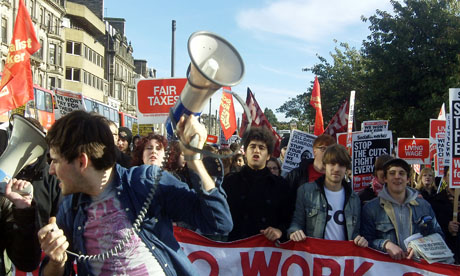Glasgow’s radical housing tradition
In Glasgow, statues adorn the city’s parks and squares from Alexandra Parade in the east, to Dumbarton Road in the west. Although erected as the permanent guardians of virtue, passersby can be forgiven for feeling a sense of disconnect to these figures that loom large above them. The Duke of Wellington was victorious at Waterloo, but how does the average Glaswegian relate to this achievement? Sir Robert Peel repealed the Corn Laws, but why are no women immortalised for their political achievements in the city’s grandest square?
Thankfully, the statue of Mary Barbour which will soon be unveiled in Govan will be a welcome exception to this rule. Despite being a leading figure in the rent strikes of 1915, which resulted in rent restrictions being imposed in Glasgow for the duration of the Great War, Barbour is largely an unsung hero of the city’s radical tradition. The statue in her honour, which will stand in the ward she represented as one of the city’s first female councillors, is a culmination of public support and the fundraising efforts of the Remember Mary Barbour Association. 
Barbour’s statue will be unveiled on 17 November, exactly 102 years to the day that she marched on Glasgow Sheriff Court with her army of followers. It has been said that the rent strikes of 1915 were a response to the cynical opportunism on the part of the city’s private landlords. With fathers, husbands and sons enlisted abroad, and house-building at an historic low, rents were increased and tenants who were unable to pay were routinely evicted. As Maggie Craig, author of When the Clyde Ran Red, said: ‘What the landlords had not reckoned with was the fighting spirit of Glasgow’s housewives’.
We can learn a lot form the unyielding socialist principles of the rent strikes, as well as the power of community as a form of social resistance. But perhaps more importantly, Barbour’s struggle is one that so many can relate to today.
In the post Grenfell Tower era, housing issues have returned to the public consciousness and to the heart of political debate. It is becoming increasingly difficult to argue that we are not living in the midst of a housing crisis. Property remains an all too easy means of accruing wealth, with inadequate restrictions, and a dire lack of social housing alternatives leaving many tenants in precarious circumstances. In Glasgow, a worker earning minimum wage can now expect to part with up to 80% of their monthly income on accommodation alone. This trend will only get worse so long as the cost of rent outstrips the rate of pay, and with over 340,000 people privately renting in the city, the implications of this are bleak.
The street names of Glasgow are a homage to the wealth of merchants and tobacco barons of yesteryear. It is a cruel irony, therefore, that these same streets are now the resting place each night to a homeless population which is growing at an exponential rate. Although homelessness has a multitude of causes, it would be naive to say that this is not linked to a crisis in housing, at least in part. With such gross inequality in plain sight, there is a growing sense that Glasgow must rediscover its radical tradition, if an effective resistance is to be built.
A recent example of this is the Living Rent tenants’ union which launched in July of this year. After operating as a campaign group for several years, and running branches in other Scottish regions, tenants in Glasgow can now access representation and peer support for a small monthly fee. In its short existence, Living Rent has launched a drop-in centre, protested against ‘extortionate rents’ at a housing association and joined in solidarity with groups demanding justice for Grenfell Tower victims.
One tactic in particular has caused quite a stir on social media. Living Rent regularly posts images of its members’ accommodation to highlight the shameful living standards and to expose malpractice in the sector. Images of mushrooms sprouting from damp cupboards, or walls rotting with mould, are a graphic way of raising awareness of the problem, and reaching out to people living in similar circumstances.
In September 2017, the campaign work of Living Rent and other civic movements succeeded in breaking the political deadlock around housing policy in Glasgow. A motion by the council agreed to launch a study into the feasibility of Rent Pressure Zones in the city. This was passed following cross-party support from SNP, Labour and Green councillors, which is a promising sign that progressive parties are willing to work together on such a key issue.
If implemented, rents would be capped for a period of five years, but perhaps more significantly, this is considered the first step towards introducing Rent Controls in the city. With rents having increased by an average of 34% in the preceding five years, it is evident that such legislation is essential to introduce fairness into the private rented sector.
A statue of a radical Glasgow woman is long overdue. Its humble home outside the underground station in Govan is a far cry from George Square, but it could not be more fitting. Although over a century has passed, the parallels to modern Glasgow are clear and but there is a sense of optimism in the air and evidence that communities can bring about real change. So let’s celebrate Mary Barbour, and may her statue stand proud, as a monument to an on-going struggle.
Michael O’Brien lives in Glasgow and works in the third sector. He is an activist with Unite the union.



